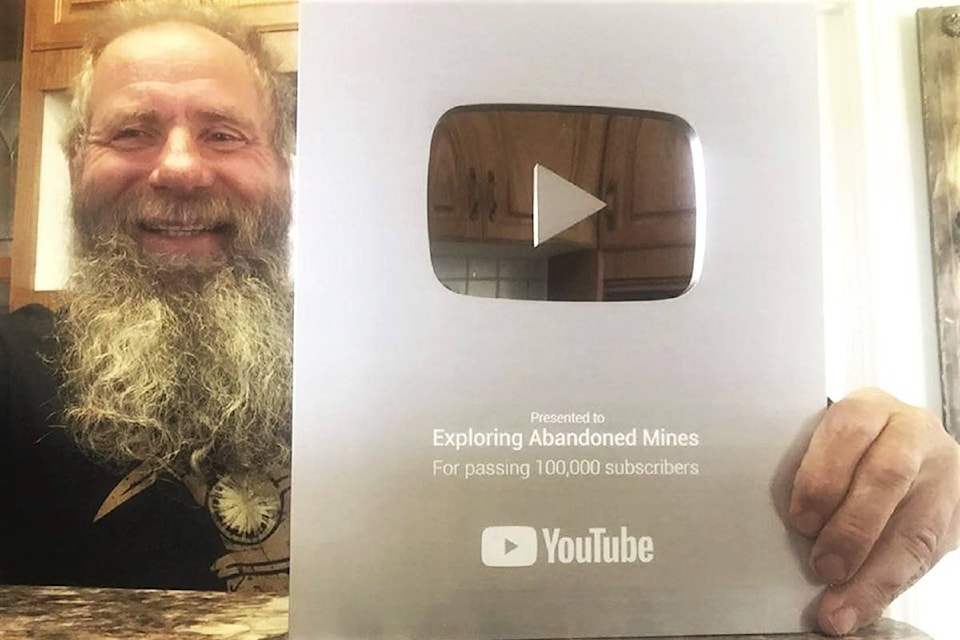“Logically, there’s no reason why I should be nervous,” Frank Schlichting tells his camera as he hangs several dozen feet below a wooden truss which anchors his climbing rope, “but tell my stomach that.” His head aims the helmet-mounted camera down into the darkness of a mine shaft in the Hull Mine in Arizona, his microphone pics up short breaths.
“I should just lean back and trust the rope,” he tells no one but himself. He should be able to trust his truss above, he says. “This has got me sweating a little, I don’t know why. … I’m not gonna lie, I’m a little freaked out by this, and there’s no good reason for it. It’s just psychological.”
It’s also why his YouTube channel, Exploring Abandoned Mines, has more than 100,000 subscribers – a feat for which he was recently recognized by the company, which send a trophy to Schlichting in Grand Forks. In 2019, the number of YouTube channels to break the 100,000-subscriber barrier doubled. Nevertheless, to stand out amid some 31 million content producers is impressive, particularly considering it all started as a sort of retirement plan.
The former rancher retired to Grand Forks from Fort St. John about five years ago, which is when he noticed the extent of mineral exploration at Phoenix from the air.
“I was flying my plane overtop of Phoenix,” he recalled, “it’s just like Swiss cheese up there.” His curiosity piqued, he got down underground for a closer look to find rail tracks, ore carts, and “a big ballroom in there that looks like a skating rink.” And explosives.
“It’s a lot more fun than exploring on the surface,” Schlichting said. “A lot of this stuff is just perfectly preserved and it’s been over 100 years since it was closed,” he said, remarking on the Phoenix site.
Naturally, wading through tunnels bored and blasted out of rock is not the safest of hobbies. As such, Schlichting says he’s learned to be prepared over the course of his explorations, which have seen him rappel below the earth’s surface — always with his oxygen monitor, helmet, an array of lights, waders, ropes and clothing.
Of course, equipment costs money, and though he gets ad revenue from his 30-minute videos on YouTube – often between $1,500 and $3,000 per month, he says — the costs of travel, maintenance and gear eat that up fast.
Sometimes it feels like work, like when he’s hunting for the next site. “It can get a little dreary there, checking out all these things and there’s nothing there,” but that flips off as soon as there’s an access route.
Though the mine exploration part of his retirement plan came as a bit of a surprise, Schlichting says that he’s always been interested in filmmaking. He had a different YouTube channel to document his flights as a pilot, but he said, “it was kind of difficult to make it interesting and it wasn’t really gaining much traction.”
Thousands of people fly across B.C. every day, all treated to varying views of peaks and rivers – far fewer have the access, ability and the nerve to tromp around underneath that scenery, but it’s evident that many are more than happy to follow Schlichting along through the passageways of old mines.
“It’s like going for a hike or something like that,” said the filmmaker. “You’re always gonna look around that next corner and see what you can find.”
In 2018, Telus recognized what his unique lens could reveal, awarding him a $50,000 grant through the Telus STORYHIVE project. Schlichting used the funds to document Anyox, a mine 60 kilometres north of Prince Rupert that was run by the Granby Company – the same that provided the foundation for industry in Grand Forks.
The growth of the channel comes with a growth of the person too. Schlichting has learned the skills needed to stay safe underground, and to stay calm, despite what some moments of his videos may betray.
“When you’re never been underground, you’re kind of nervous about it,” he said. “But then you get pretty comfortable with the with the mines and the technology, and it lets you get into places that you never would have went into before.” Nevertheless, there are times when his basic physiology might disagree.
